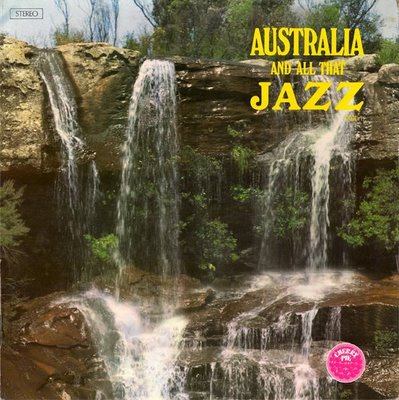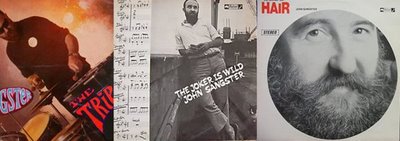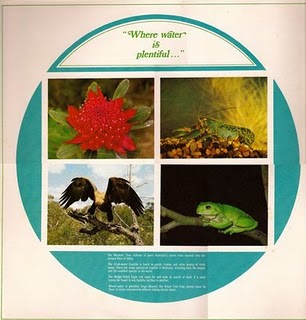Artist and musician Simon Hunt publishes one of the best music blogs around – Never Enough Rhodes – writing on jazz, obscure funk oddities and neglected gems of hybridised musical madness. One such forgotten masterpiece is the work of Australian jazz composer John Sangster whose Australia and All That Jazz mixes lite soundtrack – with field recordings…Here hunt explains some of the background to Sangster’s career and the strange birth of the album…
AUSTRALIAN JAZZ – THE LIBRARY CONNECTION #3
Some jazz, some bossa rhythms, and some easy-listening-musique-concrète soundtrack all in the one package. What a bargain!
John Sangster’s fascinating soundtrack album for a series of nature documentaries is buried behind one of the one of the worst, most generic titles of all time – not to mention the skanky record cover, which doesn’t even have his name on it – but that was the lot of the commissioned library/soundtrack composer in 1970s Australia.
On the upside, that’s probably a factor that allowed me to grab it for $3 at a street market a few months back, rather than having to pay the hundreds of dollars that some of his albums go for. Anyway, it’s something of a buried treasure that we’ll try and dig up today.
John Sangster was a vibraphonist, percussionist and composer who started out in fairly straight-ahead jazz groups as a cornettist, releasing two albums in the late 1940s. During the 1960s he developed an interest in the avant garde and then broadened his listening and composing to latin and other musical forms, releasing three albums that are now quite hard to get hold of – “The Trip” (1967), “The Joker Is Wild” (1968) and “Ahead of Hair” (1969). The last of these was an idiosyncratic, percussion-laden take on the musical “Hair”, recorded while he was working as a drummer in the Sydney stage version alongside prog-rock group Tully.
During the mid to late 1960s, Sangster was also a member of the Don Burrows Quartet, and played on the album “The Jazz Sound Of the Don Burrows Quartet”, previously featured on this blog.
That group, combined with Sangster’s vibes, formed the core sound for a series of soundtracks by renowned soundtrack composer Sven Libaek, including “Inner Space” and “Solar Flares”.
“Australia and All That Jazz” was commissioned by the Australian Museum – a museum of natural history – as the soundtrack for a series of 16mm wildlife documentary films by the museum’s filmmaker Howard Hughes (no, not that one). Working here with the Burrows group and three additional woodwind players, Sangster himself plays vibraphone, an array of percussion and occasional simple fender rhodes (see the “Rain” preview at the top).
Ironically, the bulk of the funding for the project was provided by mining company BHP, perhaps as a payback for the fact that they were ripping up the Australian landscape at the time and wiping out much of the wildlife being celebrated here.
Sangster had previously worked on Sven Libaek’s soundtrack for a series of nature documentaries that ran under the title “Nature Walkabout”. Libaek’s 1965 soundtrack had followed the standard formula, applying “human” drama to the scenes of animal activities and the power of nature.
For a nature documentary score, Sangster’s approach here is radically different to that of Libaek – he incorporates the sound of nature itself into the soundtrack, via field recording, tape manipulation and melodic scoring for instruments – including Don Burrow’s flute utilising echo-delay – that reflects the calls of birds, other animals and the elements.
While these are techniques that were common to the work of classical and experimental composers of the time, it was unusual to hear them both in a jazz context and used in such a lyrical fashion. Later on the the 70s and 80s these sort of techniques were used and abused in a range of appalling “new age” music, but here there’s still a freshness.
Nature’s drama is also reflected in rhythmic sequences that reference occasional latin and afro-style beats, in the time-honoured 70s library tradition of non-european cultures being seen as ‘wild’, but also stemming from Sangster’s genuine love for and engagement with a range of musics.
The first of his albums to cross over with his environmental interests, it’s divided into two sides : “Where Water is Plentiful” and “Dry Australia”, referring to the titles of two of the films the music was originally scored for. This album took the structures of and ideas behind the original recordings and developed them further in the studio.
Visit Never Enough Rhodes to download the album and listen to tracks. Thanks to Simon Hunt for permission to repost.




Pingback: Tweets that mention New blog post: John Sangster: Australia and All That Jazz -- Topsy.com
My father Stan Walker was a great jazz pianist who played with Geoff Kitchen’s band at the Trocodero in Melbourne with Johnny Sangster. I am building a treasure trove of dad’s early music recordings etc (for eg he played piano in the Jive Bombers who won best british dance band in 1947 in the UK – this is where dad met Graeme Bell who was working with Sangster then)….if any one has any information, recordings, memories or critiques that are relevant to Stan out there, I would love to hear from you. Jan Walker Queensland. Email rjburguez@bigpond.com